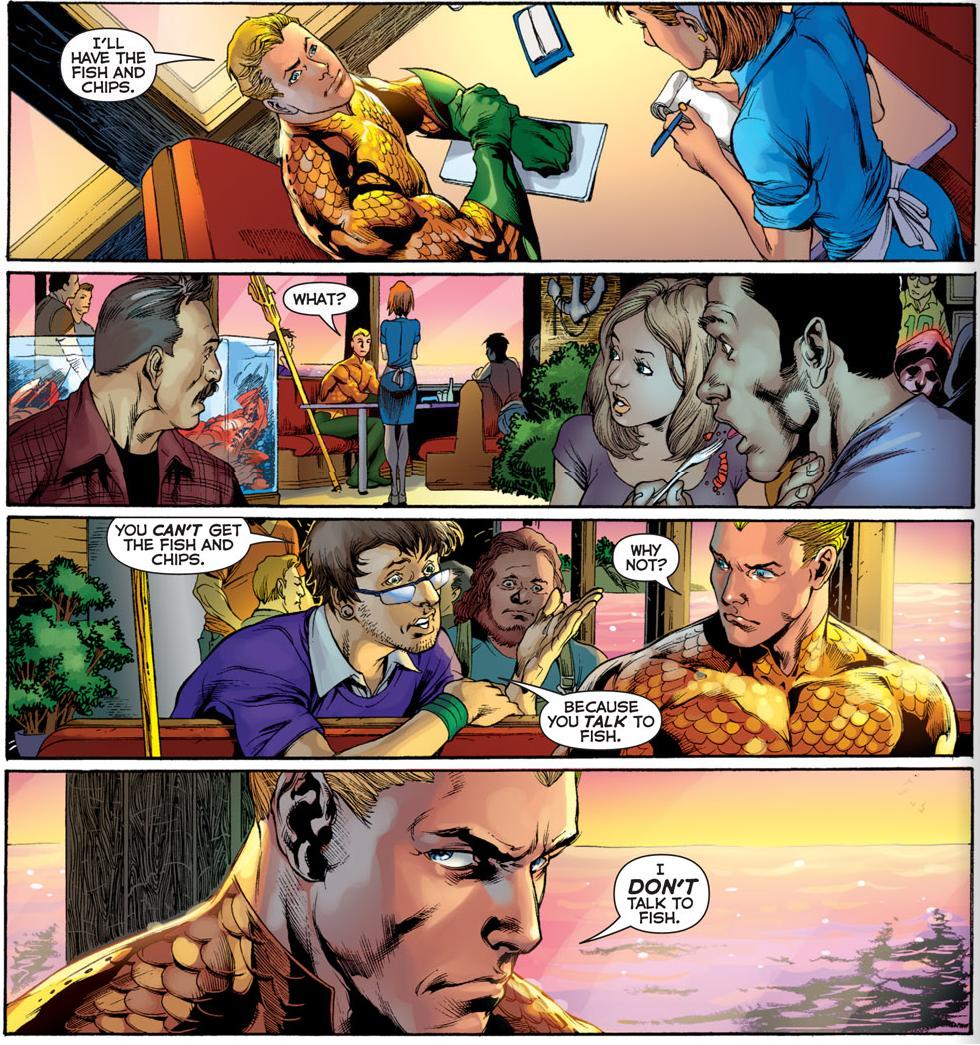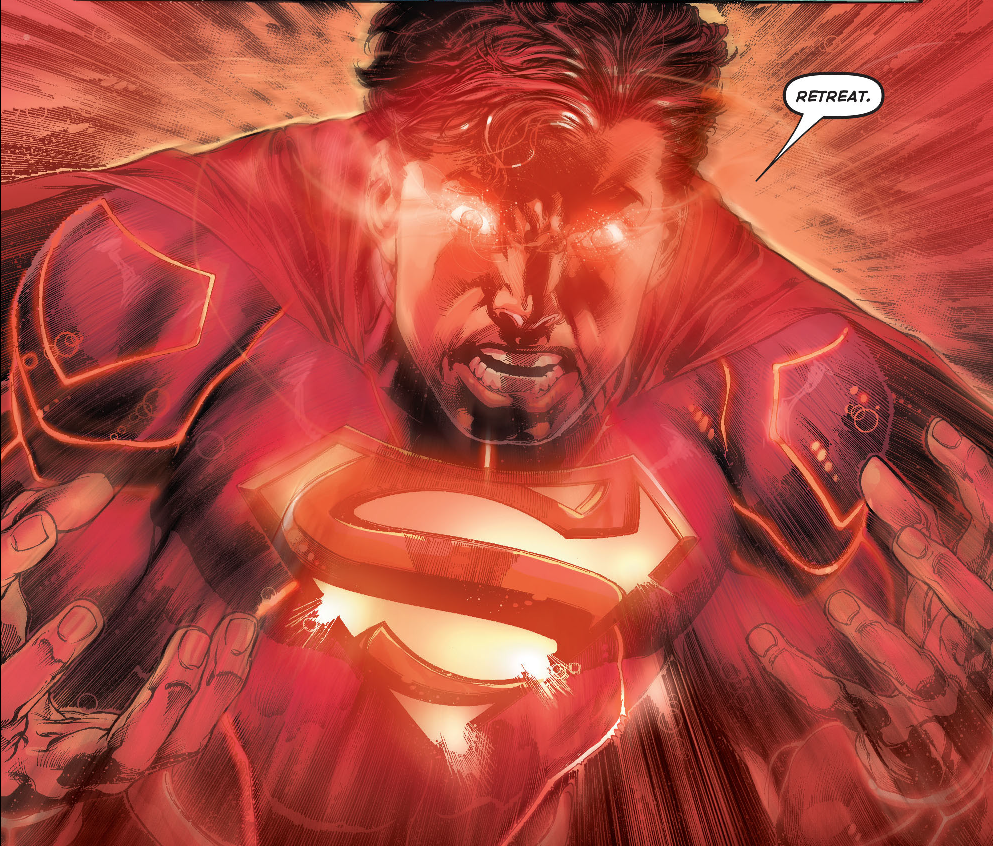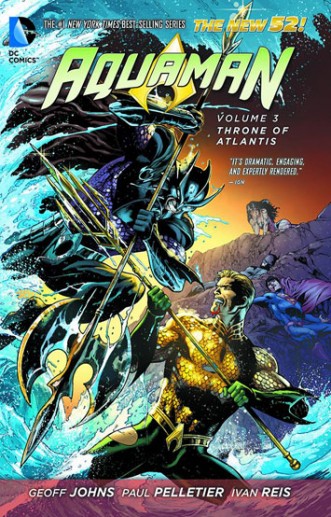Mild-mannered reporters by day, Greg Phillips and Nick Duke share an intense love of comic books that has made them the Hard-Traveling Fanboys. Over the course of their travels through comicdom, they have encountered numerous stories via the wonder of trade paperbacks and graphic novels. Once a month, Nick and Greg will review one of those collections in The Longbook Hunters.
Nick: Welcome back, ladies (if we have any female readers) and gentlemen to the special corner of cyberspace occupied by the Hard-Traveling Fanboys. This time out, we’re resisting the temptation to write about Stephen Amell for a third straight week and instead taking a trip into the depths of the ocean.
Greg: Avast ye dear readers! And welcome to this deep-sea longbook hunt, as we crack open the pages of a trade paperback featuring the king of the seas himself, Arthur Curry (a.k.a. Aquaman for you landlubbers out there). In this case, it’s the 2012-13 tale “Throne of Atlantis,” written by Geoff Johns, drawn by Ivan Reis and Paul Pelletier, and headed for DVD shelves soon in an animated outing from Warner Bros. Strap on your life jackets and get ready for more aquatic puns as we talk about one of the most unfairly maligned superheroes in existence.
Nick: This tale is unique because it took place in two separate ongoing series, yet both were written by Johns. The tale plays out in the pages of both Aquaman and Justice League, and involves an attack by the kingdom of Atlantis on the surface dwellers above.
Greg: While bouncing back and forth between the titles may have been frustrating for monthly readers of one book or the other, DC helpfully combined the story into trade form. There was a Justice League trade collecting the same issues with an extra issue or two of that title. In this case, we’re reviewing the Aquaman side, which collected issues 0 and 14-16 of Aquaman and issues 15-17 of Justice League.
Before we delve into this one, though, let’s talk about the background leading up to this one. Created in 1941 by Mort Weisinger and Paul Norris, Aquaman is actually one of the oldest superheroes still seeing monthly print. That he’s lasted so long may come as a shock to some, but he’s been a vital part of DC’s publishing output in most every decade since the ’40s. While there were certainly key runs here and there (none moreso than Peter David’s stretch writing the book in the ’90s), the character experienced a huge revitalization thanks to a 2011 reboot by Johns and Reis. As part of DC’s New 52 initiative, Johns and Reis took the building blocks of Arthur Curry and reconstructed him from the ground up, updating his powers, tweaking his origin and distilling the countless different versions of Aquaman into a single vision readers could get behind.
Nick, being largely a Marvel fan in your early comic book days, what were your initial thoughts of Aquaman, and what made you delve into the New 52 issues?
Nick: I admittedly was one of those people who scoffed at the idea that Aquaman could be an interesting or worthwhile character. However, I once thought that about many DC concepts. My entrypoint into Aquaman, as it was with many DC characters, was Geoff Johns. After his iconic Green Lantern run, I was willing to check out anything that Johns was writing. So, when he took over Aquaman at the start of the New 52, I was on board. And, despite all my misgivings about the character, Johns completely sold me with the first issue, which confronted all the typical Aquaman jokes head on. From that point on, I was hooked, and I’ve followed the series ever since.

Greg: Indeed, I was someone who had remained relatively indifferent toward the character before the reboot, but the allure of Johns was just too much for me to resist. Reading the previous two trades, “The Trench” and “The Others,” I admired Johns’ decision to confront the jokes instead of hiding from them. He quickly subverted them and used them as a clever way to show readers that, yes, this character is awesome and, yes, he belongs alongside his contemporaries in the Justice League.
While the book has plenty of humor and moments of joy throughout, it’s really a traditional superhero adventure. At times it almost feels as cosmic as Johns’ Green Lantern run due to the exotic locales visited in the deep sea.
The tale helpfully starts with a story of Arthur’s first journey to Atlantis, thanks to a meeting with a man named Vulko who once served his mother when she was queen. This meeting, and the journey that ensues, provides much of the background for the conflict that drives the book. “Throne of Atlantis” plays out like a cautionary tale of isolationist politics. Arthur is a man torn between worlds, but in this tale, it’s his quest to keep those worlds apart that comes to the forefront. Arthur’s brother, Orm, is the king of Atlantis, and he appears to be doing a fine job of running things. Orm is both frightened and disdainful of the surface world, while most on the surface aren’t even convinced Atlantis exists.
Someone from Atlantis — Arthur believes it to be Orm — has stolen a dangerous Atlantean artifact that could threaten the surface world. The seeds of mistrust are quickly sown. Meanwhile, a mysterious figure uses the artifact to free the creatures from “The Trench.” Arthur notices something is amiss when sea life begins ignoring his telepathic commands and swimming away from shore. Their survival instincts have taken over, meaning something dangerous is coming.
What did you make of these early chapters? One in particular that stood out to me was an issue that centered entirely around a single conversation between Arthur and Orm, along with a tale from one of Atlantis’ earlier encounters with the surface world.
Nick: Because my previous exposure to Ocean Master/Orm had only been through the Justice League animated series and a few random issues from years past, I was really surprised by this take on Orm. Rather than being a typical comic book, mustache-twirling villain, he winds up being one of the most relatable characters in the story. This relatability was established in these early chapters as we see exactly what drives Orm and what separates him from Arthur. However, while we see their differences, we also see that at the beginning of this tale, their differences aren’t that great. Under different circumstances, it’s possible to believe that Orm and Arthur might have been the ones to broker a peace between the surface and Atlantis. It’s this that ultimately makes the story more tragic than many superhero tales.

Greg: Like you, I had preconceived notions about Ocean Master heading into this one — he’s a straight-up villain, jealous of Arthur’s stature and lusting for the throne. Johns presents him in a much different light, as a loving brother who is fulfilling a duty that Aquaman chose to abandon.
We also meet Vulko early on, and it’s touching to see the effect Arthur’s presence has on him. Vulko has been stuck on the surface world, banished from Atlantis. Seeing Arthur instantly brings his duties back to heart, and it also affords him the chance to return home. For Arthur, it’s a particularly important bond, since so many had betrayed or abandoned him in life.
Nick: Yeah, Vulko was a character I had never heard of before. I’m still not entirely sure if he was an original creation or an updated version of a pre-New 52 character. Vulko’s connection with Arthur was a great piece of Johns’ run, as Vulko seemed like the first piece of Atlantis that Arthur was able to become endeared to and as you said, Arthur brought Vulko back to life, so to speak. Plus, the fact that Vulko once knew Arthur’s mother gives the two a chance to bond over their common history and allows Arthur to better know a woman he never met.

Greg: Thanks to the power of Wikipedia filling in my Aquaman knowledge gaps, I discovered Vulko has a long and storied history in Aquaman books, both as an ally and an enemy.
In any event, let’s get to the crux of the story. The actions of an unseen individual or individuals lead to an inadvertent nuclear strike from a U.S. warship to Atlantis. For an underwater world already suspicious of the surface, this is all that is needed to set the stage for war — a war Arthur himself had helped plan years before in the event of such an attack. With Orm rallying the troops and launching strategic attacks on certain U.S. cities (notably Gotham, Metropolis and Boston), Arthur finds himself trying to be a peacekeeper between Atlantis and his friends in the Justice League, who are out to make the Atlanteans pay for the human lives their attacks took.
The manipulation was a clever one, both from the mysterious figure and from Johns himself, as I found myself completely understanding the “why” of Orm’s actions. As the war was gearing up, I found myself empathizing with both sides. But of course, as a reader, I was privy to information the fictional sides were not.
Nick: This story is indeed notable in that even the antagonists have motivations that are completely understandable and legitimate. Honestly, throughout the story, I probably empathized with Orm the most. After the strike, he felt he had no choice but to launch a war. The people of Atlantis wanted it, first and foremost, and he knew Arthur had contingency plans for such a conflict in place. It’s also important that the decision was never one Orm wanted. He seemed content to have Arthur rule Atlantis and only took the throne because of Aquaman’s insistence on leaving Atlantis. In the end, Orm winds up being the fall guy for a series of actions he had little choice in.
Greg: With the fate of the coastal United States at stake, it makes plenty of sense when Arthur’s buddies in the Justice League show up (sans Green Lantern and Flash, who are otherwise occupied). What results is a carefully crafted balance of character moments and all-out bombastic action. The complicated relationship between Batman and Aquaman takes center stage here, as does the budding romance between Superman and Wonder Woman.

In the midst of trying to keep them from fighting each other, Arthur finds himself trading blows with both his brother and his friends. It all illustrates the skills of both the artists involved, as Pelletier can make me feel whatever Arthur is feeling at a given time, and Reis continues to cement himself as perhaps the best superhero artist in the game. Seriously, these are some of the best action panels I’ve read in a book this year, and they surpass even the great Jim Lee’s work in prior Justice League arcs.
Nick: Yeah, I was very concerned when Jim Lee left Justice League that it would lose a little bit of that certain “it” factor that had made it feel important and prestigious. However, Reis proved himself as one of the great JL artists in recent memory, and Throne is a great example of his work. As you mentioned earlier, Aquaman is a bit like Green Lantern in that the undersea worlds can often feel cosmic or otherworldly in nature. It’s easy to see then how Reis, who was an outstanding GL artist in his own right, fits right in drawing this epic Aquaman-centric story.
Greg: One interesting and bold storytelling decision from the creators is presenting — in my view, anyway — the Leaguers in a somewhat negative light.
It’s not that they’re villains at all. On the contrary, they save a great many lives and fight to defend the helpless throughout the story. However, I couldn’t help feeling that Batman, Superman and Wonder Woman all acted a bit recklessly here, whether it’s Batman taking the first shot at Orm, Superman lashing out in a rage because Wonder Woman is injured, or Diana herself seemingly stumping for war. Oddly, it’s the youngest member of the ague, Cyborg, who makes the most rational decisions throughout. Did you read this aspect the same way I did?
Nick: I think so, though I understood why each character was presented the way they were. Batman has seen his city attacked as part of the wave. Combine that with his natural distrust of characters he isn’t familiar with and you can see why he might try to be proactive rather than reactive now that he has a chance with Orm jut feet away. Superman is reacting to seeing Wonder Woman hurt in the early days of a relationship that neither character fully understands yet, making them both act uncharacteristically rash. Wonder Woman has struggled with a warrior nature since arriving in man’s world, and her injury only increases her lust for battle.

Cyborg, meanwhile, uses reason instead or rashness. He sets in motion a plan to outfit his body with components capable of visiting Atlantis in an attempt to free the League and bring an end to the war.
Greg: And while the League is subdued, Cyborg calls in the reserves. Literally. Element Woman, Hawkman, Shazam, Firestorm, Black Canary, Vixen, Zatanna, Green Arrow (sans salmon ladder) and others join the fight, doing their best to rappel the Atlantean incursion. Along the way, we get some nice comedy bits from Shazam and a brutal illustration of what separates Hawkman and the rest from the real League — judgment. Batman finds himself in the unusual position of having to rally the troops, which also leads to some great moments, including a cameo from a female Atom that would lead into a much darker story.
In a roundabout way, it’s actually Aquaman’s wife Mera and Cyborg who save the day. Mera, though she doesn’t get a whole lot of play here, has been one of the best part of Johns’ Aquaman run. She is one of the most engrossing heroes in the DC Universe, and there are some issues where she steals the show from the titular character.
Nick: If I had a complaint about the story, it would be just that — Mera has to kind of play a background role here because the League has taken over her usual role as the secondary character. As you said, Mera is a fantastic character, and probably my favorite female character in all the DC Universe. In an era where people are clamoring for more diversity, it’s about time Mera had her own series, at least in a limited run. She’s a fiercely independent, yet loyal, character that had numerous moments of female badassery under Johns’ watch, and has continued to impress since Jeff Parker took over the title from Johns.

Greg: I would most definitely buy a Mera standalone book. Her own origin is every bit as interesting as Arthur’s. And I did notice her lack of presence here, but luckily the story was outstanding enough to compensate for that loss.
By the end — and we’re avoiding spoilers here — the events of the battle between Atlantis, the League and the Trench (who become involved pretty late in the game) lead to a massive status quo change for Aquaman. To reveal it would betray many of the intricacies that play out during the story.
So let’s talk about the story in general. How did it work for you, and how did this compare to other stories featuring Aquaman, particularly in this New 52 run?
Nick: It was fantastic. It really felt like the culmination of a lot of what Geoff Johns had been building over his first year or so on the title, and having Johns as the single writer helped to avoid the sometime jarring shift in tone that can come when stories play out in multiple titles. For me, it’s right up there with “The Trench,” which is the story that sparked my interest in the character. If I’m being honest, it probably surpasses that tale, but they always say that you never forget your first.
Greg: I’d have to agree. This felt like the biggest, boldest Aquaman tale I’ve read, though it built off the template set way back in “The Trench.” Still, with a combination of fast-paced, frenetic action, touching character-based tragedy, and political conspiracies, it’s one of the most thrilling stories DC has put out in the last few years. Johns and Reis are magic together, and Pelletier doesn’t miss a beat.
Are there any particular high points that stand out to you in the book? It’s hard not to pump my fist for the inevitable Aquaman-Ocean Master throwdown — “I yield, brother.”

Nick: It’s the closing moments, where we see Vulko locked away in Atlantean prison and Orm locked away above. Both have been ostracized for doing only what they felt to be best for their people. The sadness shown on both faces is expertly rendered, and it just helps to further underscore the story’s tragic nature.
Greg: We also get a peak at a few different groups who are up to something … fishy.

And with that terrible pun, we bring an end to another hunt. We hope you’ll go to your local comic book shop or preferred online retailer and pick up “Throne of Atlantis,” because you won’t regret it. I think we both have high hopes for the animated feature, as well.
Nick: Can’t wait for that feature. Perhaps we’ll even revisit this story in a future Off the Page once the film is released.
Greg: Until then, we welcome your feedback. Did we snare you in our narrative net or did we just miss the boat on this one? Let us know through the PTBN Facebook page, Twitter (@gphillips8652 and @nickduke87) or email (GregP@placetobenation.com and NickD@placetobenation.com).
